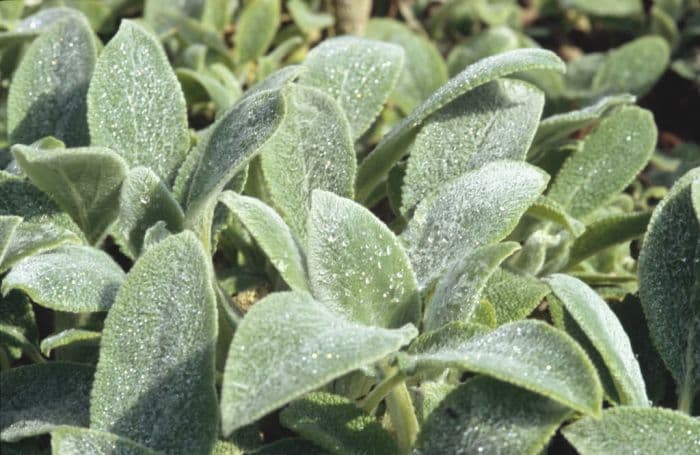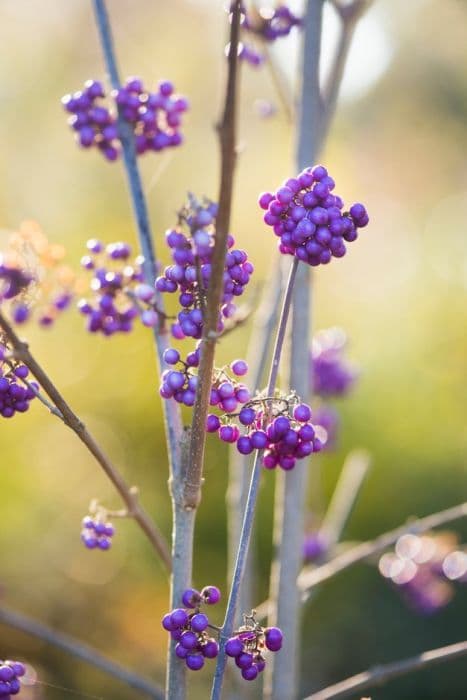Lamb's Ear Stachys byzantina 'Silver Carpet'

ABOUT
Stachys byzantina 'Silver Carpet', also commonly known as Lamb's Ear, showcases a distinctive and attractive appearance that is cherished in many gardens for its unique texture and color. The plant bears soft, velvety leaves that are often described as feeling similar to an actual lamb's ear when touched. These leaves have a silvery-grey hue which contributes to its common name and gives the foliage a shimmering appearance that stands out against the greenery of a typical garden. The leaves of Lamb's Ear are shaped like elongated ovals with a slightly rounded tip, and the edges are softly scalloped, providing the plant with a gentle, inviting look. The 'Silver Carpet' variety is particularly valued for its dense mats of foliage which spread to create a beautiful ground cover. Unlike some other varieties of Lamb's Ear, 'Silver Carpet' does not typically produce tall flower spikes and instead focuses its energy on producing lush, thick blankets of leaves. The lack of blooming stems on this cultivar further emphasizes the stunning tapestry of silver foliage, making it a desirable choice for gardeners who prefer foliage over flowers. Its overall appearance brings an element of soft texture and light, pastel coloration to any landscape, complementing bolder colors and various plant textures.
About this plant
 Names
NamesFamily
Lamiaceae
Synonyms
Lamb's Ear, Woolly Hedgenettle, Byzantine Stachys, Silver Carpet
Common names
Stachys byzantina 'Silver Carpet'
 Toxicity
ToxicityTo humans
Lamb's ear is not considered toxic to humans. There have been no widely reported adverse effects from ingesting small quantities of this plant. However, as with many plants, consuming large amounts could potentially cause gastrointestinal discomfort due to the presence of saponins and other plant compounds not intended for human consumption.
To pets
Lamb's ear is also generally considered non-toxic to pets. It is not known to cause serious harm if pets happen to ingest small amounts of this plant. Nevertheless, it's always prudent to keep an eye on pets as individual animals might have unique sensitivities, and consuming non-food items can sometimes lead to digestive upset or blockages.
 Characteristics
CharacteristicsLife cycle
Perennials
Foliage type
Evergreen
Color of leaves
Silver
Height
6-10 inches (15-25 cm)
Spread
1-2 feet (30-60 cm)
Plant type
Herb
Hardiness zones
4-8
Native area
Middle East
Benefits
 General Benefits
General Benefits- Drought Tolerance: Lamb's ear is well-suited for xeriscaping or in gardens with low water availability due to its high drought tolerance.
- Low Maintenance: It requires minimal care once established, making it ideal for gardeners seeking low-maintenance plants.
- Ground Cover: 'Silver Carpet' forms a dense, mat-like ground cover that can suppress weeds and reduce soil erosion.
- Ornamental Appeal: The plant's silvery foliage adds unique texture and color contrast to the landscape, enhancing its aesthetic value.
- Wildlife Attraction: While it produces fewer flowers, it can still attract beneficial insects that prey on garden pests.
- Hardiness: Lamb's ear is resilient to many common plant diseases and pests, contributing to its overall hardiness in the garden.
- Erosion Control: Its mat-forming growth habit is effective in stabilizing soil on slopes and banks.
- Tolerance of Poor Soil: Lamb's ear can thrive in a variety of soil conditions, including poor soils where other plants might struggle.
- Deer Resistance: The fuzzy texture of the leaves is often unappetizing to deer, making it a good option for deer-prone areas.
 Medical Properties
Medical PropertiesThis plant is not used for medical purposes.
 Air-purifying Qualities
Air-purifying QualitiesThis plant is not specifically known for air purifying qualities.
 Other Uses
Other Uses- Lamb's Ears can be used as a soft padding in gardening gloves, providing a natural cushioning.
- The leaves of Lamb's Ears are naturally absorbent and can be used as emergency dressings for superficial cuts in the garden.
- Children can use the fuzzy leaves of Lamb's Ears to craft homemade "fuzzy friends" or as natural "beds" for small toys.
- Lamb's Ears can serve as a contrasting texture in floral arrangements alongside more traditional flowers.
- The plant can be used in sensory gardens due to its unique and inviting tactile quality.
- Lamb's Ears foliage can be used in natural dyeing processes to achieve subtle green and yellow hues.
- The silver foliage of Lamb's Ears can be included in wreaths and other decorative seasonal items, especially for fall and winter decor.
- The leaves can be placed underfoot to create a soft and silent pathway in gardens.
- The silver color of Lamb's Ears make them a useful addition to moonlight gardens, being reflective at night for a unique visual effect.
- Lamb's Ears can be used for teaching children plant biology and botany due to its distinct leaf structure and growth patterns.
Interesting Facts
 Feng Shui
Feng ShuiLamb's Ear is not used in Feng Shui practice.
 Zodiac Sign Compitability
Zodiac Sign CompitabilityLamb's Ear is not used in astrology practice.
 Plant Symbolism
Plant Symbolism- Softness: The plant Stachys byzantina 'Silver Carpet' is commonly known as Lamb's Ear due to its soft, velvety leaves which resemble the texture of a lamb's ear. The soft foliage symbolizes a gentle nature and comfort.
- Protection: Lamb's Ear has been traditionally used in folk medicine for its antibacterial properties and to dress wounds. As a result, the plant symbolizes protection and healing.
- Prosperity: With its quick-spreading habit and easy-to-grow nature, Lamb's Ear can symbolize abundance and prosperity.
- Persistence: The resilience of Lamb's Ear to grow in poor soils and its drought tolerance lends it the symbolic meaning of persistence and the ability to thrive in difficult conditions.
 Water
WaterLamb's ear requires moderate watering, especially during dry periods. It's advisable to water this plant thoroughly once a week, allowing the soil to dry out between waterings. Over-watering or allowing the plant to sit in water can lead to root rot, so ensure good drainage. A good rule of thumb is to provide about 1 gallon of water per square foot every 7 to 10 days, adjusting based on weather conditions and soil drainage.
 Light
LightLamb's ear thrives in full sun to partial shade. The ideal location for this plant would be a spot where it receives at least 6 hours of direct sunlight daily. However, in extremely hot climates, some afternoon shade is beneficial to prevent scorching of its silver-fuzzy leaves.
 Temperature
TemperatureLamb's ear does well in a wide range of temperatures, but ideally, it prefers conditions between 60 to 80°F. It can survive minimum temperatures down to 30°F and maximum temperatures up to about 85°F. Providing good air circulation can help the plant cope with higher temperatures.
 Pruning
PruningPruning Lamb's ear is primarily done to remove spent flower stalks and to maintain its shape. Deadheading, or removing the old flower spikes, can encourage a second bloom. Pruning can be performed throughout the growing season as needed. The best time for a more thorough pruning is in early spring, to remove any damaged or dead foliage from winter.
 Cleaning
CleaningAs needed
 Soil
SoilLamb's ears prefer well-draining soil enriched with organic matter and minimal watering. Ideal soil pH ranges from 6.0 to 7.5. A mixture of loam, peat, and sand works well for proper drainage and aeration.
 Repotting
RepottingLamb's ears are typically not repotted often as they are hardy perennials. They may only need repotting if they outgrow their space or need rejuvenation every few years.
 Humidity & Misting
Humidity & MistingLamb's ears thrive in low to average humidity conditions and do not require high humidity, making them suitable for typical outdoor environments.
 Suitable locations
Suitable locationsIndoor
Use well-draining soil, place in bright indirect light, and ensure low humidity.
Outdoor
Plant in well-drained soil, full sun to part shade, and space 12-18 inches apart.
Hardiness zone
4-8 USDA
 Life cycle
Life cycleStachys byzantina 'Silver Carpet', commonly known as Lamb's Ear, begins its life cycle as a seed, which, when sown, germinates in warm soil typically during spring or early summer. The seedling emerges and develops into a rosette of fuzzy, silvery-gray leaves close to the ground. As the plant matures during its first growing season, it continues to form a dense groundcover through vegetative growth but does not typically flower. In subsequent years, while 'Silver Carpet' is a cultivar bred not to flower heavily, it may produce sparse flowering spikes with small, purplish-pink flowers in the summer, which are less prominent than those of its parent species. The plant often spreads by creeping stems that root at the nodes and can also propagate by division in early spring or fall. In the winter, Lamb's Ear may die back, especially in colder climates, but it is a perennial and will regrow from the base the following spring.
 Propogation
PropogationPropogation time
Spring-Early Summer
The most popular method of propagating Lamb's Ears 'Silver Carpet' is through division. This form of propagation is best done in the spring or early fall. To propagate by division, carefully dig up an established clump of Lamb's Ears and gently separate the plant into smaller sections, making sure each section has a portion of the root system intact. Trim any excessively long roots and replant the divisions at the same depth they were growing at before, spacing them about 12 to 18 inches (30 to 45 centimeters) apart to ensure adequate room for growth. Keep the newly planted divisions well-watered until they are established and showing signs of new growth.








